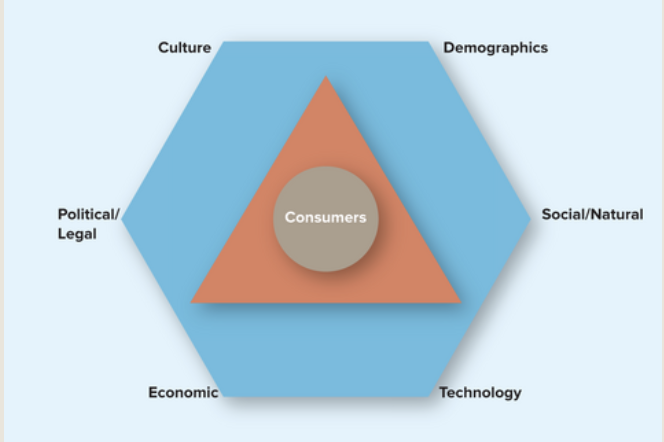Chp 3 - Analyzing the Marketing Environment
1/23
There's no tags or description
Looks like no tags are added yet.
Name | Mastery | Learn | Test | Matching | Spaced |
|---|
No study sessions yet.
24 Terms
consumers microenvironment
company → microenvironment → corporate partners → competition → consumers

company capabilities
1st factors that effects the consumer (the firm itself)
Successful marketing firms focus their efforts on satisfying customer needs that match their core competencies
competition
Significantly affects consumers in the MICROenvironments
apple vs samsung
corporate partners
Few firms compete in isolation
Ex. Automobile manufacturers, very competitive environment
Supplier relationships necessary to produce automobiles successfully
consumers macroenvironment [CDSTEP]
culture
demographics
social/natural
technology
economic
political/legal

culture
shared meanings, beliefs, morals, values, and customs of a group of people
country culture
artifacts, behaviour, dress, symbols, physical settings, ceremonies, language differences, colours and tastes, and food preferences
regional subculture
The region in which people live in a particular country affects the way they react to different cultural rituals, or even how they refer to a particular product category
demographics
indicate the characteristics of human populations and segments, especially those used to identify consumer markets
age, ethnicity, income, gender, race
generational cohort
A group of people of the same generation
often have similar purchase behaviours because they have shared experiences and are in the same stage of life
Gen Z
known as digital natives
The majority of Gen Z shoppers cite social media ads as the biggest influence on their purchasing behaviour. Social justice is an expectation, and Gen Z demands that brands take action and give back
Gen Y
millennials or the “echo boom” generation
grew up in a more media-intensive and brand-conscious era than their parents. They are more skeptical about what they hear in the media, which makes marketing to this group even more challenging
Gen Yers are defined by their expectations regarding the work world and for being savvy digital consumers
Gen X
people born between 1965 and 1980
Gen X is the first generation of latchkey kids (those who grew up in homes in which both parents worked)
Having grown up in times of economic recession, they are more likely than previous generations to carry higher debt loads, travel the world, and move far away from their parents.
Baby Boomers `
born between 1946 and 1964
largest cohort in Canada
upper class consumers
more affluent, spending not influenced by economic conditions
High discretionary incomes and tend to purchase luxury items
To have an excess income of $226000 is top 10% of Canadians
middle class consumers ($41,707 - $100,260)
Majority on higher end
Afford a good life
Careful spenders, value conscious
38% of Canadians
working class ( > $41,707)
families rep 14% of pop & earn $17267-$41707
20% Canadians spend five or six times more in every shopping category than 20% of p
why is ethnic demographic shift important for marketers
The challenge is for marketers to understand the culture, value, and spending patterns of the various groups and determine the best way to communicate and serve them
technological advancements
technological changes that have contributed to the improvement of the value of both products and services in the past few decades
Accelerated through decades
Mobile devices enhance customer experience making it easier to interact w manufacturer and retailer
AI
Solutions that rely on computer systems to perform tasks requiring human intelligence, such as speech recognition, decision making or translations
Increasing debate of hype or useful: Already being experimented w for systems reliant on human intelligence: speech recognition, decision making or translations
Potential to fast-track sustainability in carbon intensive industries
Ex. AI with Maplesoft -> Helping students solve math problems
use it for “advanced customer segmentation, media selection and buying” and customer engagement
green marketing
strategic effort by firms to supply customers with environmentally friendly merchandise